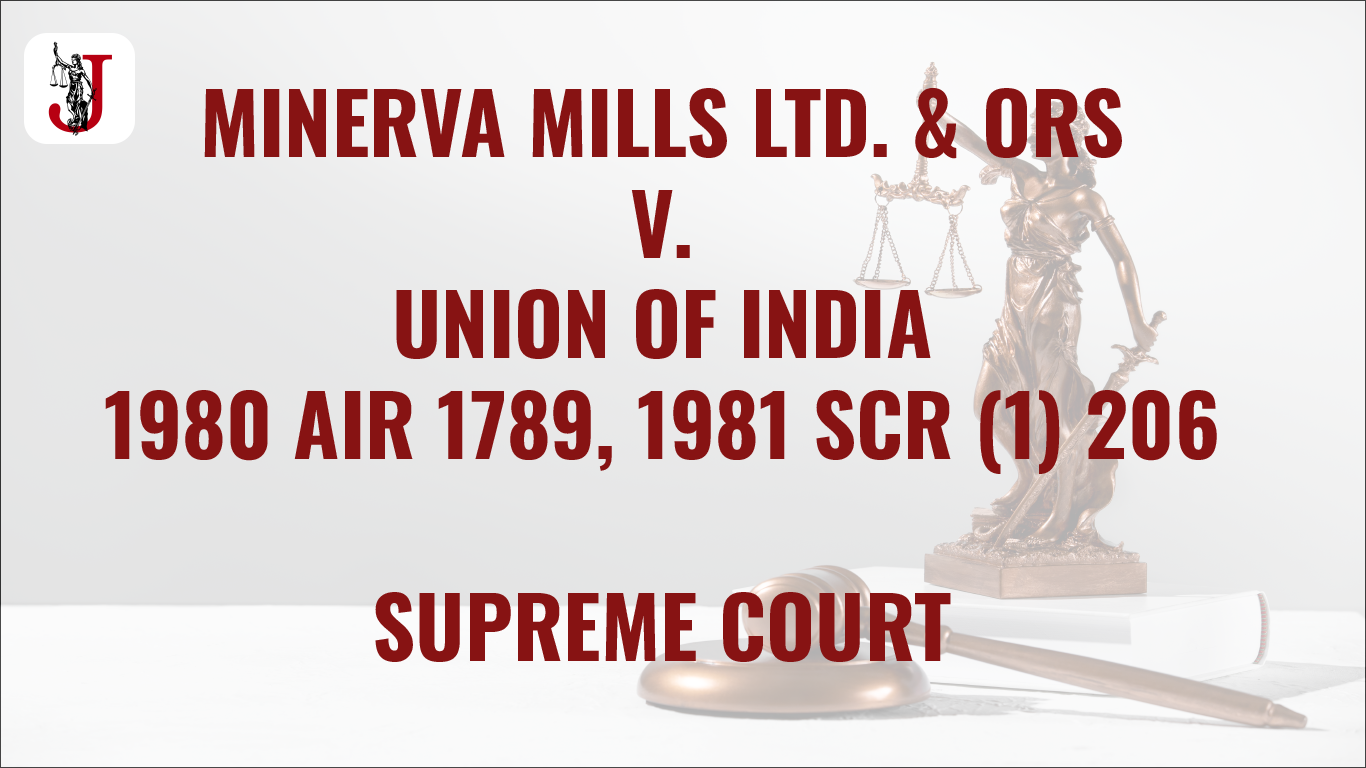1980 AIR 1789, 1981 SCR (1) 206
Introduction
There is a conflict that arose in this case between fundamental rights and the directive principles of state policy.
Fact
- The Parliament had enacted The Sick Textiles Undertakings (Nationalization) Act, 1974, in the interest of the general public.
- Its purpose was to provide for commodities at fair prices so that the public would not be affected. Minerva Mills Ltd. was a textile company that worked in the business of producing silk clothes.
- The Central Government appointed a committee to do an investigation on the working mechanism of Minerva Mills Ltd., and an order was passed to take complete control of the undertaking, Minerva Mills Ltd.
- The petitioner challenged this decision of the government before the Supreme Court through petitions on several issues.
Legal Issues
1. Whether insertions made under Article 31C and Article 368 through Sections 4 of the Constitution (42nd Amendment) Act, 1976, are constitutionally valid?
2. Whether clauses 4 and 5 under Article 368 are constitutionally valid?
3. Whether the Directive Principle of State Policy has primacy over the Fundamental Right to the Indian Constitution?
Judgement
1. Validity of 42nd Amendment Act, 1976 (Article 31c)
Section 4 of the 42nd Constitutional Amendment Act brought changes in Article 31 C. The amendment gave supreme power to the Directive Principle of State Policy. It protected the law under Article 39(b) and (c) from any kind of judicial review under Articles 14 or 19 of the Constitution. The situation arose from a conflict between fundamental rights and the directive principle of state policy.
The Ld. court said that there should be harmony between Part III and Part IV of the Constitution, as they are the essential features of our Constitution and part of the basic structure doctrine.
Article 31 C provides the power to the Directive Principles of State Policy to achieve its goals by harmonizing the fundamental rights, as both of these are essential features of the Constitution. Thus, the insertion of Article 31 C through Section 4 of the 42nd Amendment was declared unconstitutional.
2. Validity of Article 368
Clause 5 of Article 368 (Basic Structure Doctrine)
The Ld. Court explained at clause 5 of Article 368, which gives unlimited power to amend, that the Parliament is of a limited nature.
The Court also said that the Parliament, under Article 368, cannot go beyond the basic structure doctrine as established in the Keshvananda Bharati Case.
Clause 4 of Article 368 (Power of Judicial Review)
The court, while examining clause 4 of Article 368, which provides the validity of the amendment act and cannot be brought before judicial review, is also unconstitutional. The court explained that the power of judicial review is to create a check and balance between the rights of citizens and the dictatorship of the government.
Thus, the Supreme Court declared clauses 4 and 5 of Article 368 unconstitutional.
3. The judgment makes it clear that the Constitution is supreme and not the Parliament. The ld. Court held in this case that Fundamental Rights and Directive Principles of State Policy are both the double sides of a coin; one cannot be prioritized by submerging the other. The Court added two new features to the list of basic structure features: judicial review and balance between Fundamental Rights and DPSP.
Conclusion
To conclude, it can be said that the government tried multiple times to control the power, but the judicial system always gives checks in such attempts by the government.
Youtube facebook whatsapp web weather translate google amazon gmail google translate Instagram cricbuzz traductor Hotmail restaurants satta king tiempo twitter googel maps Yandex Sarkari result clima hotels fb yahoo maps chatgpt yahoo mail weather tomorrow Netflix roblox nba wordle tradutor livescore premier league ibomma speed test canva pintrest outlook Instagram login omegle flipkart myntra paypal paytm Alibaba ebay lottery sambad linkedin tiktok shein bbc news real madrid gmail login Walmart ikea cricket snaptik flashscore English to hindi twitch google scholar Barcelona Sarkari Naukri matrimonial shadi lgbtq third gender woman children Advocate barrister vakil supreme court high court commissioner exams ll.b ll.m ugc net law ph.d. m.b.a. graduation degree certificate school additional session judge civil judge justice jurists crime criminology punishment capital sentence death warrant fine constitution of india criminal procedure code civil procedure code evidence act sale of goods act arbitration act all india bar exam lower judiciary higher judiciary additional district attorney contract act amendment act u.s. constitution Canada p r section article schedule judgment vacancy post Porsche louis Vuitton chanel Gucci Hermes dior cartier rolex titan tiffany & co Ferrari estee lauder coach lancome burberry prada omega yves saint Laurent Lamborghini ray-ban Armani Moncler tata reliance Givenchy celine Bentley tag Heuer sk-II can cleef & arpels bulgari Shangri-la lao feng xiang dabur baidyanath cipla birla monte carlo loewe rolls-royce bottega-veneta jaege-leCoulture Maserati valentino dolce & gabbana Salvatore Ferragamo sulwhasso tom ford Maruti Suzuki Hyundai kia intercontinental Tissot aston martin ysl beauty fendi Versace kenzo la mer longines gold price sensex human rights pollution
